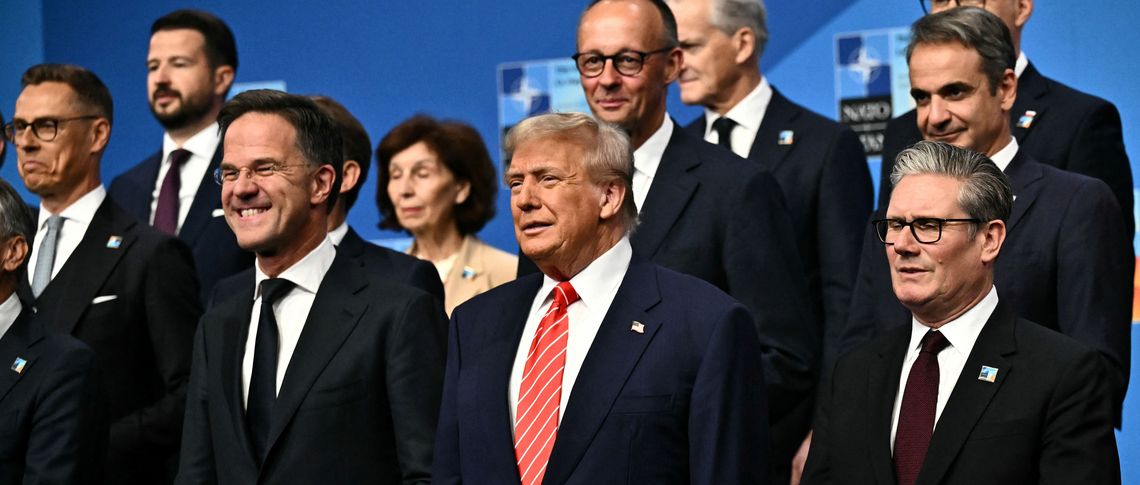‘Donald, you have driven us to a really, really important moment for America and Europe, and the world. You will achieve something NO American president in decades could get done. Europe is going to pay in a BIG way, as they should, and it will be your win.’
This is the sort of obsequiousness that one has come to expect from Trump’s acolytes in the US. One can see it live on Fox News, if one is so inclined. But coming from the NATO Secretary-General, Mark Rutte, on the eve of the NATO Summit in The Hague, it still came as a surprise.
The Alliance trumpets the Summit as a big success, because Allies committed to spend 5 per cent of GDP on defence: 3.5 per cent on core defence requirements, and 1.5 per cent on infrastructure, resilience, the industrial base etc. The latter would not normally be counted as defence spending, but NATO now does and for one reason and one reason only: Trump, who conjured up a number, 5 per cent, out of thin air, which then somehow became the deliverable for The Hague. And everyone accepted it — or pretends to.
For the reality is that Spain said what many think: though some Allies in Eastern Europe already are at 4 to 5 per cent, most others do not seriously intend to reach the 5 per cent target. It is, in fact, neither necessary nor feasible. Spain’s last minute letter to the Secretary-General made it difficult for any other Ally to support it, due to it also rejecting the 3.5 per cent, which is necessary and based on actual defence planning by NATO military staff. What Europeans should have done is mustered some courage and, early on, inform the US: ‘We don’t think 5 per cent is necessary, but 3.5 per cent is, and we will develop a serious plan to achieve that goal.’
Fundamental rethinking needed
The fact that this did not happen shows that it is not NATO that has a problem, but Europe. Europe is the only global power (for that is what it is) that talks itself into being so weak that it sees no other strategic role for itself than to be the most loyal ally of the US. Even if the current US administration treats its allies as rivals, is ideologically opposed to the EU, wages a tariff war against Europe, and interferes in its domestic politics to support the extreme right. All of which Trump will mostly likely continue to do, in spite of having secured his 5 per cent. Yes, he left The Hague in a good mood – but does anyone seriously believe that this will last?
To be clear, maintaining NATO and the broader Transatlantic partnership is a vital European interest. As long as the price for doing so does not itself threaten those vital interests.
Our armed forces are precisely meant to defend our way of life, at the heart of which are democracy, the free market, and the welfare state.
For one, it must be understood that the welfare state is as vital for the security of Europe as the armed forces: the latter to ward of external enemies, the former, by providing social cohesion and stability, is to keep internal enemies, all those who abuse democracy to run on an anti-democratic platform, at bay. Dismantling social security for the sake of defence – which is what 5 per cent will oblige many to do – is meaningless. Our armed forces are precisely meant to defend our way of life, at the heart of which are democracy, the free market, and the welfare state. The majority of the public sees the necessity for increased defence spending but overdoing it will destroy that basis of support. Social security is not beyond reform, of course, but the bulk of the money for the necessary 3.5 per cent will have to be found elsewhere – just as we did during the Cold War, when we were at that level of defence spending.
Second, the Trump administration itself has made it explicitly clear that Europeans have to assume ownership of their own conventional defence, due to the US’ focus on China. At the Summit, Trump did commit to Article 5 (even though on the way over there he told journalists that it depended on the interpretation). But the reality is that the US view now is that Europe has to staff the first line of conventional deterrence and defence itself, and that American reinforcements may arrive much later, and in smaller numbers, than counted on hitherto. European armed forces, however, have been configured to operate within an American-enabled framework, not independently.
A viable NATO thus demands a fundamental rethinking of the force posture. The NATO Defence Planning Process (NDPP) now seeks to build one coherent force package, Americans and Europeans combined. But most of the strategic enablers for that package are provided (almost) exclusively by the US: intelligence, communications, command and control, transport, deep strike etc. And yet, the US has just communicated that Europe should not count on these the way it used to. The solution is obvious: reconfigure the NDPP and build two fully interoperable but separate force packages. One provided by the US, and one by everybody else combined. Each package should be fully autonomous in the military sense, with its own strategic enablers, so that they can (indeed must) support each other, but no longer depend on each other (as is Europe’s case today).
Building a militarily autonomous European pillar, under a single NATO command structure and North Atlantic Council, will create the stable equilibrium on which the future of NATO can be based.
This ought to have been the discussion in The Hague. The percentages in themselves don’t mean much without an idea of which force one is building. Moreover, if all Europeans spend more separately, they will remain as dependent on the US as before, for no individual European state has the capacity to fill the gap qua strategic enablers that the new US approach has left us with. It is vital that a significant part of the additional defence spending be pooled to acquire collective European strategic enablers. The role of the EU then is to facilitate this through its defence industrial and budgetary policies.
What is NATO, after all? It was never meant to be an American protectorate over Europe, but that is nearly what it has become. What it should be is an alliance of equals. That it is unequal, is Europe’s fault, for cutting too deep in its defence budgets after the end of the Cold War. Building a militarily autonomous European pillar, under a single NATO command structure and North Atlantic Council, will create the stable equilibrium on which the future of NATO can be based. Or, in a worst case scenario, if the US would leave NATO, it would allow Europeans to continue the Alliance alone, because its command structure and planning process work. In the best case scenario, Europeans, through the EU, and the US, each set their own Grand Strategy, coordinate, and avail themselves of the powerful military instrument that NATO is.
‘This will push the Americans away,’ many will say. But this US administration has already taken its distance from us, moving way past arm’s length. They don’t need to be pushed. US leaders, across party lines, see Europe as less and less relevant to great power politics. Europeans should remember: strong players can conclude beneficial alliances; weak players pay the price for their protection – or of their abandonment.






